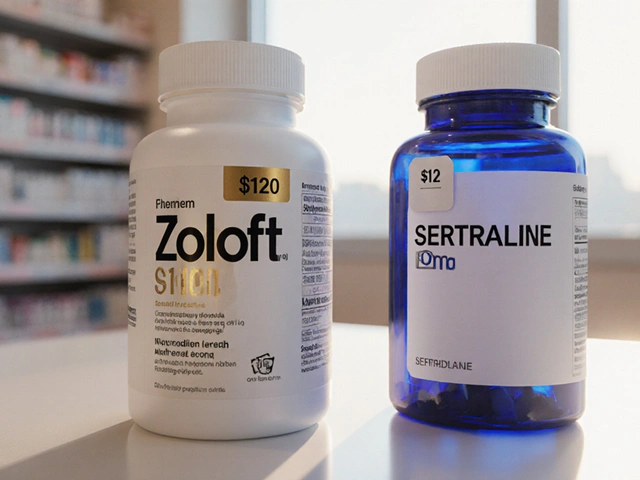Alzheimer's Medication Choice Guide
Select the patient's condition to get personalized medication recommendations:
Stage of Disease
Gastrointestinal Sensitivity
Sleep Issues
Insurance Coverage
TL;DR
- Aricept (Donepezil) is a once‑daily acetylcholinesterase inhibitor approved since 1996.
- Rivastigmine and Galantamine are older AChE inhibitors with different dosing schedules and side‑effect profiles.
- Memantine works via a separate NMDA‑antagonist pathway and is often combined with an AChE inhibitor.
- Cost varies: generic Donepezil and Rivastigmine are cheapest; brand‑only formulations of Galantamine and Memantine are pricier.
- Choosing the right drug depends on tolerability, dosing convenience, disease stage, and insurance coverage.
When a loved one gets an Alzheimer’s diagnosis, the first question is usually “what medication should we start with?” Aricept alternatives abound, but they differ in how they work, how you take them, and how much they cost. This guide breaks down the most common prescriptions - Donepezil, Rivastigmine, Galantamine, and Memantine - so you can see which one fits your situation best.
Donepezil is a selective acetylcholinesterase (AChE) inhibitor marketed as Aricept. It boosts brain acetylcholine levels, easing memory lapses in mild‑to‑moderate Alzheimer’s disease. FDA approved it in 1996 and generic versions have been on the market since 2010.
Rivastigmine, sold under the brand name Exelon, is another AChE inhibitor that also blocks butyrylcholinesterase. It’s available as oral capsules and a transdermal patch, giving flexibility for patients who struggle with tablets. FDA cleared it for Alzheimer’s in 2000 and for Parkinson’s‑related dementia in 2007.
Galantamine, marketed as Razadyne, is a third‑generation AChE inhibitor that also modulates nicotinic receptors, which may add a small cognitive boost. It received FDA approval in 2001.
Memantine is an N‑methyl‑D‑aspartate (NMDA) receptor antagonist. Instead of increasing acetylcholine, it protects neurons from excess glutamate excitotoxicity. FDA approved it for moderate‑to‑severe Alzheimer’s in 2003, and it’s often paired with an AChE inhibitor for a “dual‑therapy” approach.
How the Drugs Work: Mechanistic Snapshot
Understanding the underlying mechanism helps explain why side‑effects differ.
- AChE inhibitors (Donepezil, Rivastigmine, Galantamine) prevent breakdown of acetylcholine, a neurotransmitter essential for memory formation. By prolonging its action, they modestly improve cognition and daily functioning.
- NMDA antagonist (Memantine) blocks the pathological over‑activation of NMDA receptors by glutamate, which can damage brain cells. This slows disease progression rather than directly improving memory.
Because AChE inhibitors rely on cholinergic pathways, they commonly cause gastrointestinal upset (nausea, vomiting, diarrhea). Memantine’s side‑effects revolve around dizziness, headache, or constipation.
Dosage & Administration: What to Expect
Choosing a drug often boils down to how easy the regimen is for the patient.
| Drug | Formulation | Typical Starting Dose | Maintenance Dose | Frequency |
|---|---|---|---|---|
| Donepezil | Tablet, oral solution | 5mg | 10mg (optional 23mg for severe cases) | Once daily |
| Rivastigmine | Capsule, transdermal patch | 1.5mg BID (capsules) or 4.6mg/24h patch | 6mg BID (capsules) or 9.5mg/24h patch | BID (capsules) or once‑weekly patch change |
| Galantamine | Immediate‑release tablet, extended‑release tablet | 4mg BID (IR) or 8mg QD (ER) | 24mg BID (IR) or 24mg QD (ER) | BID (IR) or once daily (ER) |
| Memantine | Tablet, oral solution | 5mg QD | 20mg QD (titrated over weeks) | Once daily |
Side‑Effect Profiles: Which One Tolerates Best?
Side‑effects often decide whether a prescription stays on the shelf or gets switched.
- Donepezil: nausea, insomnia, muscle cramps; generally mild because of once‑daily dosing.
- Rivastigmine: more GI‑related issues (vomiting, loss of appetite); skin irritation possible with the patch.
- Galantamine: dizziness, weight loss, GI upset; requires titration to avoid peaks.
- Memantine: dizziness, headache, constipation; rarely causes severe nausea.
Older patients on multiple meds may experience additive anticholinergic burden with AChE inhibitors, making Memantine a safer stand‑alone option when cognition is already moderate‑to‑severe.

Cost Considerations: What Does Your Wallet See?
Insurance coverage varies by country, but here’s a U.S. snapshot for a typical 30‑day supply (generic when available).
| Drug | Generic Availability | Approx. Monthly Cost |
|---|---|---|
| Donepezil | Yes (since 2010) | $30‑$45 |
| Rivastigmine | Yes (capsules 2012, patch 2014) | $35‑$55 |
| Galantamine | Yes (generic 2012) | $45‑$70 |
| Memantine | Yes (generic 2010) | $45‑$80 |
In New Zealand, the Pharmaceutical Management Agency (PHARMAC) subsidises Donepezil and Rivastigmine, making them the most affordable first‑line choices for many patients.
When to Combine Therapies
Guidelines from the American Psychiatric Association suggest adding Memantine when AChE inhibitors no longer provide noticeable benefit, typically at moderate‑to‑severe stages. The combination (e.g., Donepezil+Memantine) has shown modest additive gains in MMSE scores over monotherapy.
Combination is not recommended for mild disease because the extra cost and side‑effects outweigh the limited cognitive boost.
Practical Decision‑Tree for Caregivers
- Is the patient in the mild stage? - Start with Donepezil 5mg QD (lowest cost, simplest regimen).
- Does the patient have significant GI sensitivity or trouble swallowing pills? - Consider Rivastigmine patch (once‑weekly). Watch for skin irritation.
- Are nighttime insomnia or vivid dreams trouble? - Galantamine may exacerbate sleep issues; Donepezil’s insomnia risk is lower.
- Has the disease progressed to moderate‑to‑severe and cognition still declines despite AChE inhibitor? - Add Memantine, starting at 5mg QD.
- Is insurance coverage limited to specific brands? - Choose generic versions of Donepezil or Rivastigmine first.
Key Takeaways
- All four drugs are FDA‑approved, but they belong to two distinct classes.
- Donepezil wins on convenience (once‑daily) and cost.
- Rivastigmine is useful when oral intake is a problem, though the patch can cause skin reactions.
- Galantamine offers a nicotinic boost but requires careful titration.
- Memantine targets a different pathway and shines in later disease stages or when combined with an AChE inhibitor.
Frequently Asked Questions
Can I switch from Donepezil to Rivastigmine if I get stomach upset?
Yes. Many clinicians transition patients to the Rivastigmine patch when oral AChE inhibitors cause persistent nausea. The patch bypasses the gastrointestinal tract, but you’ll need to monitor skin for irritation.
Is it safe to use Donepezil and Memantine together?
Combining an AChE inhibitor (Donepezil) with Memantine is approved for moderate‑to‑severe Alzheimer’s. Studies show modest cognitive benefits and no major drug‑interaction concerns, but watch for additive dizziness.
How long should someone stay on Aricept before deciding it’s not working?
A trial of at least 12 weeks at the target dose is standard. If there’s no measurable change in daily functioning or MMSE score, discuss alternatives with the neurologist.
Are there natural supplements that can replace these prescription drugs?
No supplement has proven efficacy comparable to FDA‑approved medications. Some antioxidants and omega‑3s may support brain health, but they cannot replace AChE inhibitors or NMDA antagonists for treating Alzheimer’s.
What should I do if my loved one forgets to take their pill?
Set up a daily reminder-phone alarm, pill organizer, or caregiver check‑in. For patients who miss doses often, the Rivastigmine patch or a once‑daily formulation (Donepezil, Memantine) reduces the risk of missed administrations.










6 Comments
Hey everyone, I totally get how overwhelming the med choices can feel. The good news is most of these drugs have a fairly predictable side‑effect profile, so you can match them to what the patient tolerates best. If the caregiver worries about GI upset, starting low and going slow is usually the safest route.
It is imperative to observe the precise nomenclature when referring to acetylcholinesterase inhibitors; the term "AChE inhibitor" should be consistently capitalised, and drug names such as Donepezil, Rivastigmine, and Galantamine must be italicised in formal writing.
Totally hear you, Abdul! I love the attention to detail, but sometimes we forget that the families just need clear, friendly advice, not a grammar lecture. 😊
Donepezil is cheap.
While the cost may be low, one must not ignore the ethical implications of prescribing a drug that can cause insomnia and exacerbate nighttime agitation. Cheap does not always mean better for the patient’s dignity.
Alright, let’s break down the whole landscape because it’s not as simple as “pick the cheapest pill.”
First, Donepezil (Aricept) has been the workhorse for mild‑to‑moderate Alzheimer’s since 1996, primarily because you only need to take it once a day, which is a huge compliance win for caregivers. However, its side‑effects - nausea, insomnia, muscle cramps - can be a deal‑breaker for patients with sensitive stomachs or sleep issues.
Second, Rivastigmine offers a unique angle: it hits both acetylcholinesterase and butyrylcholinesterase, and you can give it as a transdermal patch. The patch bypasses the gut, so you often see fewer GI problems, but some patients develop skin irritation, especially if they have dry or sensitive skin.
Third, Galantamine is a bit of a niche player. It also modulates nicotinic receptors, which might give a slight cognitive bump, but you have to titrate it slowly because the GI upset can be pronounced. Plus, the dosing schedule is either twice daily for the immediate‑release form or once daily for the extended‑release, which can be confusing for some families.
Fourth, Memantine is the only NMDA‑receptor antagonist in this mix. It works by protecting neurons from excitotoxic damage rather than boosting acetylcholine. It’s usually introduced when the disease progresses to moderate‑to‑severe stages or when an AChE inhibitor alone isn’t enough. Side‑effects are generally milder - dizziness, headache, constipation - but you have to watch for additive dizziness if you combine it with an AChE inhibitor.
Now, cost considerations: generic Donepezil and Rivastigmine are the most affordable, hovering around $30‑$55 per month in the U.S. Galantamine and Memantine are pricier, often hitting $70‑$80 a month if you’re not on a solid insurance plan. In countries with government subsidies, like New Zealand’s PHARMAC, the pricing story changes dramatically, making Donepezil and Rivastigmine the default first‑line agents.
When deciding on a regimen, think about the patient’s disease stage, GI tolerance, ability to manage pills versus patches, sleep patterns, and insurance coverage. For mild disease, start with Donepezil 5 mg daily; if GI upset emerges, switch to the Rivastigmine patch. If insomnia is a concern, keep an eye on Donepezil’s nighttime effects and consider timing the dose earlier in the day. For moderate to severe disease, combine Donepezil (or Rivastigmine) with Memantine; this “dual‑therapy” has modest evidence for slowing decline.
Finally, never forget the human element: set up reminders, use pill organizers, and keep open communication with the prescribing neurologist. Adjustments are often needed, and what works for one patient may not work for another. The key is flexibility, careful monitoring, and staying informed about both clinical evidence and practical considerations.